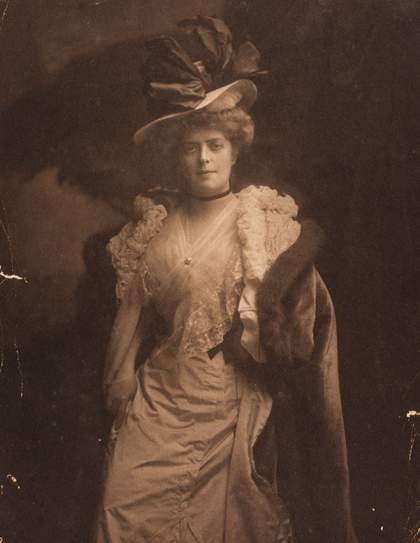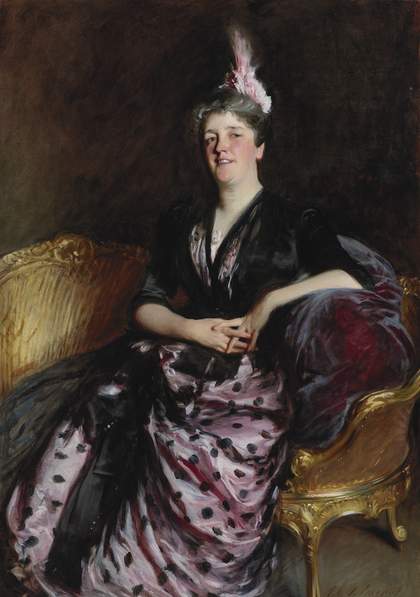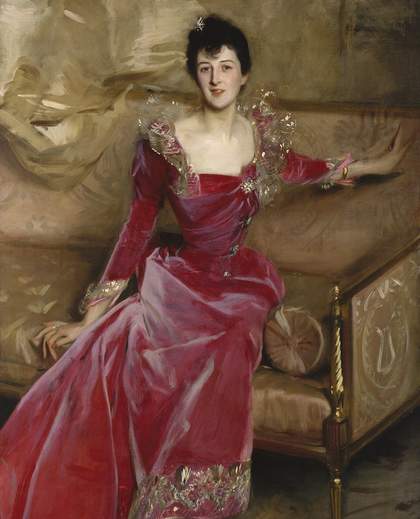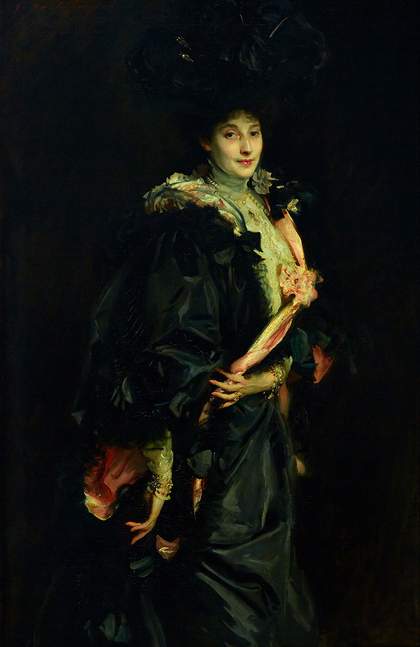
John Singer Sargent
Mrs Carl Meyer and her Children 1896
Photo © Tate
‘It’s like a bottle of champagne’, wrote one critic when Mrs Carl Meyer and her Children debuted at the Royal Academy in May 1897. ‘When I look at Mr Sargent’s picture I feel that I, too, am rich, and handsome, and happy.’ Certainly, the portrait fizzes with an irresistible fin-de-siècle glamour.
Its subject, Adèle Meyer, appears in shades of pastel pink, the opalescent sheen of her dress trimmed with frothy tulle and topped by a string of pearls spilling all the way down to her toes. The styling of the fitted bodice and wide skirt recalls Louis XV fashions, amplified by the height of Adèle’s hairdo. This spirit carries through to the interior, constructed by John Singer Sargent in his studio, which frames Adèle and her two children Frank and Elsie within elegant gilt boiserie panelling. Prominence is given to the giltwood sofa’s central motif, in which a couple appear to play music and dance – a charmingly rustic scene reminiscent of Antoine Watteau’s fête galante paintings of the 1710s.
Born in Le Havre, France in 1862, Adèle came from a German Jewish family that eventually settled in London. In 1883, she married the banker and diamond magnate Carl Meyer, who was born into a Jewish family in Hamburg, Germany and became a British citizen in 1877. While Adèle and Carl were certainly wealthy, they would have occupied an uncertain position in the eyes of the white English upper classes. In late 19th-century England, antisemitism was rife and Jewish people, as well as the so-called nouveaux riches, were looked down upon in certain circles. The evocation, therefore, of French Rococo refinement may be intended to establish the Meyers as upper middle-class cosmopolitans with their own distinct tastes and European lineage.
When the Meyers were first married, Carl was working as private secretary to Alfred de Rothschild who, as a wedding present, had their drawing room decorated. Adèle later recalled how this was ‘an almost superfluous luxury, as the whole house was in 18th-century panelling’. Rothschild had designed his own weekend residence, Halton House in Buckinghamshire, in a similar style, so his generosity seems to imply an embrace of the Meyers into his social circle of fellow wealthy Jewish families of European origin. When the couple moved some years later, they filled their new house with furniture imported from Paris, most likely including the sofa depicted in Sargent’s painting.
By the time she sat for Sargent in the summer of 1896, Adèle was already an accomplished society hostess and news- papers routinely described her parties, listing the names of notable actors and musicians in attendance. In fact, Mrs Carl Meyer and her Children is almost disarmingly ostentatious, an effect that the pair likely worked together to achieve. It has also been compared to François Boucher’s widely admired Madame de Pompadour 1756. In each case, the female subject is anchored to the composition by the sheer excess of her dress, with tiny, high-heeled feet poking out from beneath the hem. The addition of an open book in both paintings introduces a certain spontaneity that feels out of step with the rest of the carefully composed picture. As well as being a royal mistress and advisor to King Louis XV, Pompadour was known as a highly influential patron of the arts.

Photograph of Adèle Meyer, c.1900
Private collection
If Sargent was inspired by Boucher’s painting, this would have proved a fitting allusion. Both Adèle and Carl were keen fans of the theatre, giving £70,000 in 1909 to support a campaign to set up a National Theatre. While this effort would prove to be a false start (the National Theatre was eventually founded in 1963), Carl’s considerable largesse was recognised with a baronetcy. Historical accounts show, however, that the donation arrived thanks to the initiative of the writer and campaign committee member Edith Lyttelton, who managed to secure it by having ‘a quiet word with Adèle’.
A year after Sargent made his portrait, Adèle joined the Women’s Institute and eventually became a regular speaker at suffragist events. Among her many initiatives was her work as chair of (and benefactor for) St Pancras School for Mothers, a clinic and school for ‘mothercraft’ found- ed in 1907. Although Adèle was undeniably passionate about social reform, when she attended a Waifs and Strays Society meeting in 1898, the Sporting Gazette likened her appearance to ‘a dainty bit of Dresden china’. This othering description proved that, for all Adèle’s charitable campaigning, it was hard to shake societal preconceptions of her role as essentially frivolous or decorative. Even as Sargent’s painting also encourages us to delight in ornamental details of a similarly ‘foreign’ type, he ultimately tells a more complex story.
Adèle, like several of Sargent’s other sitters, appears as if she has just been interrupted while reading a book, the pages of the upturned volume still fluttering. Considering how meticulously Adèle and Sargent constructed each inch of canvas, it is tempting to read the book as an indication of her preferred pastimes and proud intellectual curiosity. In 1909 Adèle would co-write the book Makers of Our Clothes with the activist Clementina Black, in which they argued the case for a minimum wage for underpaid textile workers, after carrying out their own research into working conditions in the dressmaking industry. Although it is only with hindsight that we know how her interests would develop, it seems significant that Sargent’s portrait of Adèle chose to show her in this way.
At first glance, Mrs Carl Meyer and her Children appears to be a painting of a fashionable socialite seeking to establish herself through the power of Sargent’s brush. Look closer, however, and those subtle clues to her emerging identity as a philanthropist, suffragist and social campaigner lie hidden in plain sight.
Sargent and Fashion, at Tate Britain until 7 July 2024.
Jo Lawson-Tancred is an arts writer who lives in London.
Lead support with a generous donation from the Blavatnik Family Foundation. Additional support from the Sargent and Fashion Exhibition Supporters Circle and Tate Americas Foundation. Organised by Tate Britain and the Museum of Fine Arts, Boston. Both MFA Boston and Tate Britain received support for international scholarly convenings and for the exhibition from the Terra Foundation for American Art. Curated by James Finch, Assistant Curator, 19th Century British Art, Tate Britain, and Erica Hirshler, Croll Senior Curator of American Paintings, Museum of Fine Arts, Boston, with Chiedza Mhondoro, Assistant Curator, British Art, Tate Britain, Caroline Corbeau-Parsons, Curator of Drawings, Musée d’Orsay, and Pamela A. Parmal, Chair and David and Roberta Logie Curator of Textile and Fashion Arts Emerita, Museum of Fine Arts, Boston.




